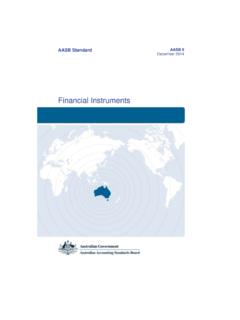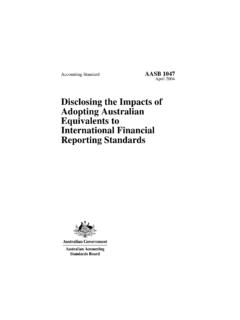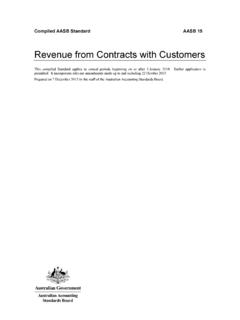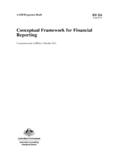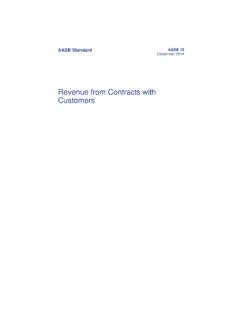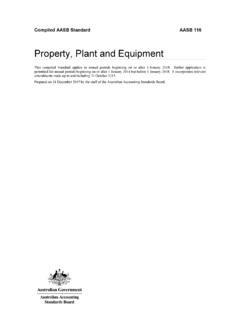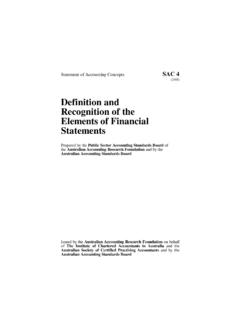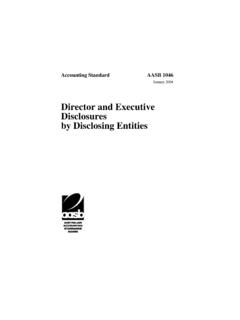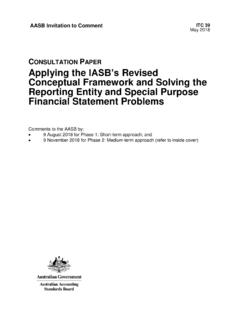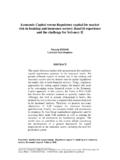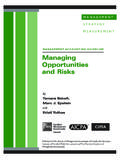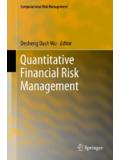Transcription of Fair Value Measurement - Australian Accounting …
1 AASB Standard AASB 13 September 2011 fair Value Measurement AASB 13 2 COPYRIGHT Obtaining a Copy of this Accounting Standard This Standard is available on the AASB website: Alternatively, printed copies of this Standard are available for purchase by contacting: The Customer Service Officer Australian Accounting Standards Board Level 7 600 Bourke Street Melbourne Victoria AUSTRALIA Postal address: PO Box 204 Collins Street West Victoria 8007 AUSTRALIA Phone: (03) 9617 7637 Fax: (03) 9617 7608 E-mail: Website: Other Enquiries Phone: (03) 9617 7600 Fax: (03) 9617 7608 E-mail: COPYRIGHT Commonwealth of Australia 2011 This AASB Standard contains IFRS Foundation copyright material. Reproduction within Australia in unaltered form (retaining this notice) is permitted for personal and non-commercial use subject to the inclusion of an acknowledgment of the source.
2 Requests and enquiries concerning reproduction and rights for commercial purposes within Australia should be addressed to The Director of Finance and Administration, Australian Accounting Standards Board, PO Box 204, Collins Street West, Victoria 8007. All existing rights in this material are reserved outside Australia. Reproduction outside Australia in unaltered form (retaining this notice) is permitted for personal and non-commercial use only. Further information and requests for authorisation to reproduce for commercial purposes outside Australia should be addressed to the IFRS Foundation at ISSN 1036-4803 AASB 13 3 CONTENTS CONTENTS PREFACE COMPARISON WITH IFRS 13 INTRODUCTION TO IFRS 13 (available on the AASB website) Accounting STANDARD AASB 13 fair Value Measurement Paragraphs Objective 1 4 Application Scope 5 8 Measurement Definition of fair Value 9 10 The asset or liability 11 14 The transaction 15 21 Market participants 22 23 The price 24 26 Application to non-financial assets Highest and best use for non-financial assets 27 30 Valuation premise for non-financial assets 31 33 Application to liabilities and an entity s own equity instruments General principles 34 36 Liabilities and equity instruments held by other parties as assets 37 39 Liabilities and equity instruments not held by other parties as assets 40 41 Non-performance risk 42 44 Restriction preventing the transfer of a liability or an entity s own equity instrument 45 46 Financial liability with a demand feature 47 Application to financial assets and financial liabilities
3 With offsetting positions in market risks or counterparty credit risk 48 52 Exposure to market risks 53 55 AASB 13 4 CONTENTS Exposure to the credit risk of a particular counterparty 56 fair Value at initial recognition 57 60 Valuation techniques 61 66 Inputs to valuation techniques General principles 67 69 Inputs based on bid and ask prices 70 71 fair Value hierarchy 72 75 Level 1 inputs 76 80 Level 2 inputs 81 85 Level 3 inputs 86 90 Disclosure 91 99 Appendices: A. Defined Terms Page 34 B. Application Guidance Page 38 C. Effective Date and Transition Page 58 DELETED IFRS 13 TEXT Page 59 ILLUSTRATIVE EXAMPLES (available on the AASB website) BASIS FOR CONCLUSIONS ON IFRS 13 (available on the AASB website) Australian Accounting Standard AASB 13 fair Value Measurement is set out in paragraphs 1 99 and Appendices A C. All the paragraphs have equal authority.
4 Paragraphs in bold type state the main principles. Terms defined in Appendix A are in italics the first time they appear in the Standard. AASB 13 is to be read in the context of other Australian Accounting Standards, including AASB 1048 Interpretation of Standards, which identifies the Australian Accounting Interpretations. In the absence of explicit guidance, AASB 108 Accounting Policies, Changes in Accounting Estimates and Errors provides a basis for selecting and applying Accounting policies. AASB 13 5 PREFACE PREFACE Introduction The Australian Accounting Standards Board (AASB) makes Australian Accounting Standards, including Interpretations, to be applied by: (a) entities required by the Corporations Act 2001 to prepare financial reports; (b) governments in preparing financial statements for the whole of government and the General Government Sector (GGS); and (c) entities in the private or public for-profit or not-for-profit sectors that are reporting entities or that prepare general purpose financial statements.
5 AASB 1053 Application of Tiers of Australian Accounting Standards establishes a differential reporting framework consisting of two tiers of reporting requirements for preparing general purpose financial statements: (a) Tier 1: Australian Accounting Standards; and (b) Tier 2: Australian Accounting Standards Reduced Disclosure Requirements. Tier 1 requirements incorporate International Financial Reporting Standards (IFRSs), including Interpretations, issued by the International Accounting Standards Board (IASB), with the addition of paragraphs on the applicability of each Standard in the Australian environment. Publicly accountable for-profit private sector entities are required to adopt Tier 1 requirements, and therefore are required to comply with IFRSs. Furthermore, other for-profit private sector entities complying with Tier 1 requirements will simultaneously comply with IFRSs.
6 Some other entities complying with Tier 1 requirements will also simultaneously comply with IFRSs. Tier 2 requirements comprise the recognition, Measurement and presentation requirements of Tier 1 but substantially reduced disclosure requirements in comparison with Tier 1. Australian Accounting Standards also include requirements that are specific to Australian entities. These requirements may be located in Australian Accounting Standards that incorporate IFRSs or in other Australian Accounting Standards. In most instances, these requirements are either AASB 13 6 PREFACE restricted to the not-for-profit or public sectors or include additional disclosures that address domestic, regulatory or other issues. These requirements do not prevent publicly accountable for-profit private sector entities from complying with IFRSs. In developing requirements for public sector entities, the AASB considers the requirements of International Public Sector Accounting Standards (IPSASs), as issued by the International Public Sector Accounting Standards Board (IPSASB) of the International Federation of Accountants.
7 Reduced disclosure requirements Disclosure requirements under Tier 2 will be determined through a separate due process with amendments being made subsequently to this Standard as required. AASB 13 7 COMPARISON COMPARISON WITH IFRS 13 AASB 13 fair Value Measurement incorporates IFRS 13 fair Value Measurement issued by the International Accounting Standards Board (IASB). Paragraphs that have been added to this Standard (and do not appear in the text of IFRS 13) are identified with the prefix Aus , followed by the number of the preceding IASB paragraph and decimal numbering. Entities that comply with AASB 13 will simultaneously be in compliance with IFRS 13. AASB 13 8 STANDARD Accounting STANDARD AASB 13 The Australian Accounting Standards Board makes Accounting Standard AASB 13 fair Value Measurement under section 334 of the Corporations Act 2001. Kevin M.
8 Stevenson Dated 2 September 2011 Chair AASB Accounting STANDARD AASB 13 fair Value Measurement Objective 1 This Standard: (a) defines fair Value ; (b) sets out in a single Standard a framework for measuring fair Value ; and (c) requires disclosures about fair Value measurements. 2 fair Value is a market-based Measurement , not an entity-specific Measurement . For some assets and liabilities, observable market transactions or market information might be available. For other assets and liabilities, observable market transactions and market information might not be available. However, the objective of a fair Value Measurement in both cases is the same to estimate the price at which an orderly transaction to sell the asset or to transfer the liability would take place between market participants at the Measurement date under current market conditions (ie an exit price at the Measurement date from the perspective of a market participant that holds the asset or owes the liability).
9 3 When a price for an identical asset or liability is not observable, an entity measures fair Value using another valuation technique that maximises the use of relevant observable inputs and minimises the use of unobservable inputs. Because fair Value is a market-based Measurement , it is measured using the assumptions that market participants would use when pricing the asset or liability, including assumptions about risk. As a result, an entity s intention to hold an AASB 13 9 STANDARD asset or to settle or otherwise fulfil a liability is not relevant when measuring fair Value . 4 The definition of fair Value focuses on assets and liabilities because they are a primary subject of Accounting Measurement . In addition, this Standard shall be applied to an entity s own equity instruments measured at fair Value . Application This Standard applies to: (a) each entity that is required to prepare financial reports in accordance with Part of the Corporations Act and that is a reporting entity; (b) general purpose financial statements of each other reporting entity; and (c) financial statements that are, or are held out to be, general purpose financial statements.
10 This Standard applies to annual reporting periods beginning on or after 1 January 2013. This Standard may be applied to annual reporting periods beginning on or after 1 January 2005 but before 1 January 2013. If an entity applies this Standard to such an annual reporting period, it shall disclose that fact. The requirements specified in this Standard apply to the financial statements where information resulting from their application is material in accordance with AASB 1031 Materiality. Scope 5 This Standard applies when another Standard requires or permits fair Value measurements or disclosures about fair Value measurements (and measurements, such as fair Value less costs to sell, based on fair Value or disclosures about those measurements), except as specified in paragraphs 6 and 7. 6 The Measurement and disclosure requirements of this Standard do not apply to the following: AASB 13 10 STANDARD (a) share-based payment transactions within the scope of AASB 2 Share-based Payment; (b) leasing transactions within the scope of AASB 117 Leases; and (c) measurements that have some similarities to fair Value but are not fair Value , such as net realisable Value in AASB 102 Inventories or Value in use in AASB 136 Impairment of Assets.
